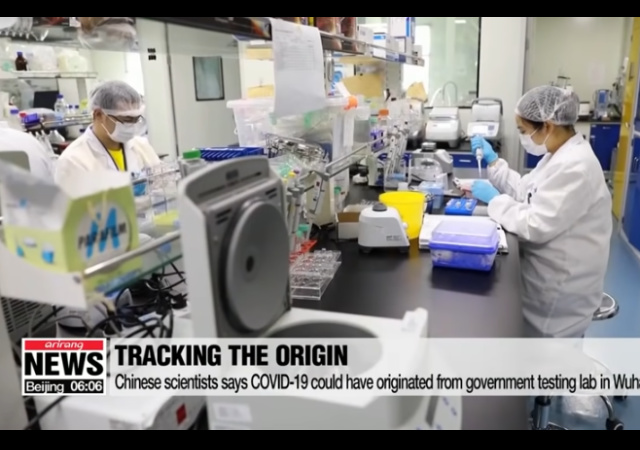Risk Analysis Tool Determined 70% Chance That Covid Originated from Wuhan Lab

Legal Insurrection has covered the reports on the potential lab leak origins of the novel coronavirus (SARS-Cov-2), the infectious agent in the now endemic bouts of COVID-19 since February 2020.
Stories our team has covered since that time support the assertion that COVID’s origins were from a lab leak from the Wuhan Institute of Virology.
- Majority of 17 international intelligence agencies believe COVID-19 started as accidental release from Wuhan lab.
- CNN’s Sanjay Gupta Supports Former CDC Director’s ‘Informed’ Theory That COVID Escaped From Wuhan Lab
- Classified Study: COVID-19 Could Have Originated in Chinese Lab
- Wuhan Lab Leak ‘Is Now the Most Likely Origin of COVID’ – MIT/Harvard Scientist Tells UK MPs
- Letter Offers More Evidence of Wuhan Lab Project Source of COVID Pandemic
- Experts Assert ‘Rare’ Genome Sequencing Shows Coronavirus Bioengineered, Optimized for Human Infectivity
While the mainstream media will occasionally trot out the idea that Chinese pangolin stew was the source of the virus, more and more evidence continues to pile up that the Wuhan Institute of Virology is likely ground zero for the pandemic.
To begin with, researchers from Australia and Arizona recently used a highly comprehensive risk analysis tool to weigh the chances that the SARS-CoV-2 virus was of ‘unnatural’ or ‘natural’ origin.
The team compared the characteristics of the virus and the pandemic to 11 criteria that analyzed things like the rarity of a virus, the timing of a pandemic, the population infected, the spread of a virus and the unexpected symptoms of a virus.Based on the nature of Covid, researchers assigned a score to each category – less than 50 percent meant the pandemic would be classified as a natural outbreak, but 50 or more percent would mean the pandemic was an unnatural outbreak.Covid received a score of 68 percent.The study said: ‘The origin of [Covid] is contentious. Most studies have focused on a zoonotic origin, but definitive evidence such as an intermediary animal host is lacking….Co-author Dr Raina MacIntyre, a professor of Global Biosecurity at the University of New South Wales, told DailyMail.com: ‘The key point [the findings] make is that the likelihood of [Covid] originating from a lab is non-trivial and cannot be dismissed as a conspiracy theory.’
Nicholas Wade is a former science editor of the New York Times. Legal Insurrection readers will recall that Wade published a detailed review of the pandemic and persuasively argued that a leak from a laboratory at the city’s Institute of Virology must be seriously considered the original source of the contagion.
Wade recently published a piece in The Wall Street Journal about a 2018 proposal to manipulate bat viruses using methods that seem to be directly related to the observed molecular structure of the novel coronavirus.
The proposal for Project DEFUSE specified that the viruses’ infectivity would be enhanced by inserting into them a genetic element known as a furin cleavage site. Depending on the starting viruses, this protocol could have produced SARS-CoV-2, the virus that causes Covid-19, which has a distinctive furin cleavage site.In 2022 three biologists, Valentin Bruttel, Alex Washburne and Antonius VanDongen, guessed that if SARS-CoV-2 had been generated in a lab by a standard method, it would have been assembled from six sections of lab-synthesized DNA with the help of a biological agent called BsmBI. On analyzing the virus’s structure, they found evidence for the seams between sections and other distinctive marks of the assembly process.Their paper was derided as “kindergarten molecular biology” by the virologists who are favorites of the mainstream press for their opposition to the lab-leak hypothesis. But a batch of documents reveal new details about the DEFUSE proposal and confirm that the three authors were on target. Emily Kopp of U.S. Right to Know obtained the documents through a Freedom of Information Act request from the Interior Department, having noticed that a researcher at the U.S. Geological Survey was a member of the DEFUSE team.The new documents, which are background planning papers and drafts for the DEFUSE proposal, call for assembling SARS-like viruses from six sections of DNA, and include a cost estimate for purchase of the BsmBI restriction enzyme—exactly as the three authors had inferred. This clearly strengthens, perhaps conclusively, their contention that the virus is synthetic.
Richard H. Ebright, a molecular biologist at Rutgers University, stresses the importance of the evidence related to the DEFUSE project.
“[The document] elevates the evidence provided by the genome sequence from the level of noteworthy to the level of a smoking gun,” Ebright said in the piece by former New York Times editor Nicholas Wade….The proposal was ultimately rejected and denied funding by the US Defense Advanced Research Projects Agency, but Wade suggested that their work could have been carried out by researchers in Wuhan who had secured Chinese government funding.“Viruses made according to the DEFUSE protocol could have been available by the time Covid-19 broke out, sometime between August and November 2019,” wrote Wade, a former science editor of the New York Times.
CLICK HERE FOR FULL VERSION OF THIS STORY